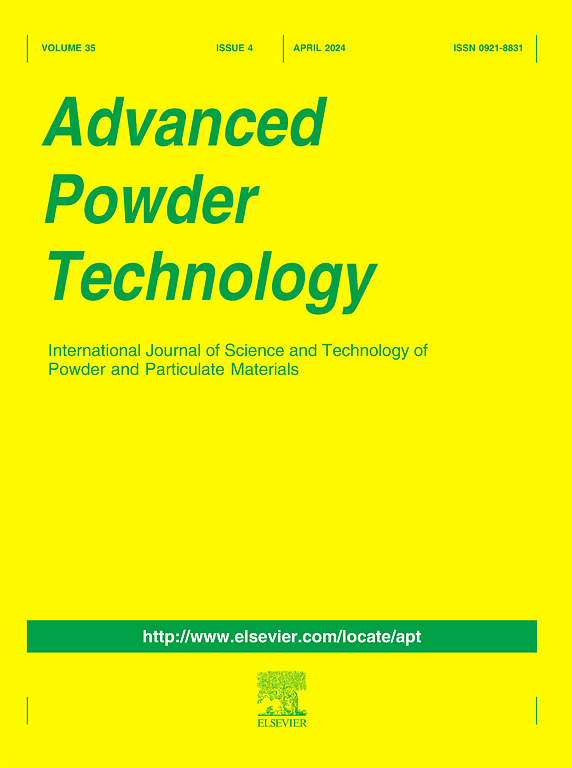Novel entrance and exit designs towards fully developed dual Vortexes in cyclone separators
IF 4.2
2区 工程技术
Q2 ENGINEERING, CHEMICAL
引用次数: 0
Abstract
Stairmand-type cyclones are commonly used in industry to separate particles from gas streams by inertia, driven by the dual-vortex flow patterns. Here, new designs are proposed to eliminate the local non-ideal vortex patterns in a conventional Stairmand cyclone by inserting a flow divider at the entrance and adjusting the elbow exit orientation. A two-way coupled CFD–DPM approach is employed to analyze the performance of the modified cyclones. Simulation results show that the cyclone with the elbow exit oriented orthogonal to the entrance direction demonstrates better performance in terms of the cut size and sharpness. The installation of the flow divider reduces the vortex eccentricity by approximately 50%. The flow divider increases the gas velocity near the outer wall, allowing the quasi-free vortex in the cyclone’s outer region to become nearly fully developed at the entrance section through the reduction of the local secondary recirculation flows. The optimum flow divider outer wall thickness correlates to the wall shear stress distribution. With the optimum 2 mm outer wall thickness flow divider installed, the separation efficiency for 2 μm particles increases from 56.74% to 77.4%, and the cut size decreases from 1.87 μm to 1.23 μm.

针对充分发展的旋风分离器双涡的新颖进出口设计
楼梯式旋风通常用于工业中,由双涡旋流模式驱动,通过惯性将颗粒从气流中分离出来。本文提出了一种新的设计方法,通过在入口插入分流器和调整弯头出口方向来消除传统楼梯旋风中局部的非理想涡型。采用双向耦合CFD-DPM方法分析了改进型旋风的性能。仿真结果表明,弯头出口与入口方向正交的旋流器在切割尺寸和锐度方面表现出更好的性能。分压器的安装使旋涡偏心率降低了约50%。分流器增加了外壁面附近的气体速度,通过减少局部二次再循环流动,使得旋风器外区的准自由涡在入口段得到近乎充分的发展。隔板的最佳外壁厚度与壁面剪应力分布有关。当最佳外壁厚度为2 mm的隔板安装时,2 μm颗粒的分离效率从56.74%提高到77.4%,切割尺寸从1.87 μm减小到1.23 μm。
本文章由计算机程序翻译,如有差异,请以英文原文为准。
求助全文
约1分钟内获得全文
求助全文
来源期刊

Advanced Powder Technology
工程技术-工程:化工
CiteScore
9.50
自引率
7.70%
发文量
424
审稿时长
55 days
期刊介绍:
The aim of Advanced Powder Technology is to meet the demand for an international journal that integrates all aspects of science and technology research on powder and particulate materials. The journal fulfills this purpose by publishing original research papers, rapid communications, reviews, and translated articles by prominent researchers worldwide.
The editorial work of Advanced Powder Technology, which was founded as the International Journal of the Society of Powder Technology, Japan, is now shared by distinguished board members, who operate in a unique framework designed to respond to the increasing global demand for articles on not only powder and particles, but also on various materials produced from them.
Advanced Powder Technology covers various areas, but a discussion of powder and particles is required in articles. Topics include: Production of powder and particulate materials in gases and liquids(nanoparticles, fine ceramics, pharmaceuticals, novel functional materials, etc.); Aerosol and colloidal processing; Powder and particle characterization; Dynamics and phenomena; Calculation and simulation (CFD, DEM, Monte Carlo method, population balance, etc.); Measurement and control of powder processes; Particle modification; Comminution; Powder handling and operations (storage, transport, granulation, separation, fluidization, etc.)
 求助内容:
求助内容: 应助结果提醒方式:
应助结果提醒方式:


